IGERT Trains Students at the Intersection of Neuroscience and Engineering
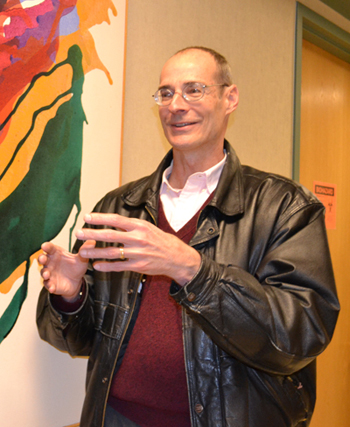
Douglas Jones, Professor of Electrical and Computer Engineering and Principal Investigator of the Neuroengineering IGERT
December 26, 2012
"We're trying to develop a culture and a community of people here on campus that are interested in the intersection of neuroscience and engineering."
According to program coordinator Pat Grenda, this is the goal of the Neuroengineering IGERT at Illinois. Short for "Neuroengineering: A Unified Educational Program for Systems Engineering in Neuroscience," the five-year Ph.D. program is funded by a National Science Foundation Integrative Graduate Education and Research Traineeship (IGERT) grant. In its fourth year, the IGERT currently has 45 students enrolled in four cohorts.
Because the grant provides only two years of support for each student; additional funding for students and program administration comes from a variety of other departments and units on campus. Tto formalize the program so it can live on past the duration of the grant, IGERT personnel are working to create a graduate concentration in Neuroengineering.
The IGERT has proved to be a useful recruiting tool; the 26 students from Cohorts 3 and 4 are enrolled in Illinois' Neuroengineering program as a result of the IGERT. However, the first two cohorts were selected from students already enrolled at Illinois because notification of funding came too late to actually recruit. The program, which targets students at the beginning of their program, also emphasizes the recruitment of students from underrepresented groups, such as women and minorities. Although no one has graduated yet, a number of students are on target for graduation in the next couple of years.
Capitalizing on faculty and resources already on campus, the IGERT focuses on three neuroengineering areas: imaging, auditory, and brain-machine interfaces. Participants span several colleges, departments, and a range of disciplines: neuroscience, psychology, molecular and cellular biology, electrical and computer engineering, bioengineering, and the medical scholars program; students are admitted to a program in their own discipline.
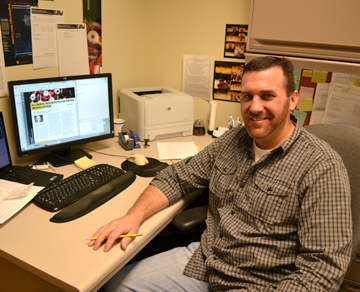
J. Patrick Grenda, Program Coordinator for the Neuroengineering IGERT
A chief goal of the program is to foster interdisciplinary collaboration. "We're trying to develop this community of researchers," says Grenda, "and give our students enough information and background in the other side of the discipline. So if they are neuroscientists or psychology people, we want to give them enough of an engineering background that they are able to communicate more effectively, collaborate more effectively, anticipate what engineers can bring to the table, and vice versa. We're not trying to make them into engineers; we're not trying to make our engineers into neuroscientists."
To familiarize students with the other discipline, the program has designed a core set of courses. According to PI Douglas Jones, a professor in Electrical and Computer Engineering, the courses compress into one or two courses the standard succession of courses most departments require. "In the first two years, the idea really was to build a program that would bring the students up to speed in the other discipline sort of quickly. Because the standard thing is, if you're an engineer, let's say, and you want to do something with Neuroscience, they would say, 'Well, go take these two years of biology courses and come back when you've taken these 17 courses.' I mean, that could work, but few people have the energy or resources to do that. Similarly, if you're from the neuroscience side, it's like, 'Ok, well, we've got these 17 courses you've got to take in engineering before we can actually talk to you about it—so you can understand what we're talking about.' So the idea was to short circuit that to some extent."
Most students take an introductory "crash course" in the other discipline. For example, neuroscience students take an introductory electrical engineering course, Principles of Signal Analysis, which Jones developed. He claims it answers the question, "How do you take the data, the signals you would pick up from the brain, and process and extract information from them?" He then goes on to explain that the course is a composite of several other courses: "In engineering, there are three prerequisite courses you would have to take, but we've taken the two weeks from this course, the three weeks from that course, and the seven weeks from another course, and condensed them into one course that is tailored toward the kinds of signals they would work with, such as neural signals from the brain or imaging signals from MRI."
Engineering students take co-PI Bob Wickensburg's Introduction to Systems Neuroscience, which is about the parts of the brain and how it works. "The idea," says Jones, "is to pull out the pieces that are most relevant for engineers who are looking at the systems neuroscience area."
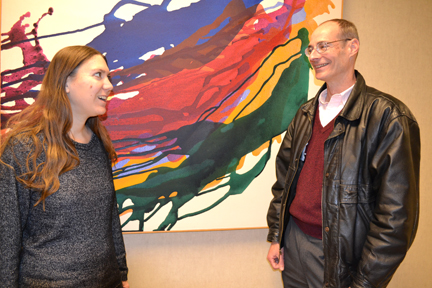
Danielle Dickson, an IGERT student in the Psychology Department's cognitive neuroscience division, and Doug Jones catch up about her research.
Once students have finished the introductory courses, it's expected that they'll be knowledgeable enough in the other discipline that they can take the department's regular courses. Elaborates Jones: "We're at a point where students just now know enough they can mainstream into some of the standard courses. That gives engineering students just enough neuroscience that they can take some of the regular neuroscience courses with other neuroscientists. These are the standard courses, such as audition, speech and hearing measurement, neuroscience imaging; neuroscientists can take engineering courses on MRI, signal processing for speech and hearing, brain-machine interfaces, or robotics."
Meanwhile, students take courses in their own disciplines. Jones stresses that the neuroengineering courses are supplementary; participation in the program shouldn't be a detriment to training in a student's own discipline. He goes on to explain the conundrum they face regarding a program in a still-emerging field.
"Supposing we created a total neuroengineering program, totally separate and all that? The graduates get a neuroengineering degree, but then, what do they do? Who's going to hire them? Nobody has neuroengineering departments in the country. They're going to have to get hired into a neuroscience or psychology department or an engineering program, and if they can't stand on their own two feet among those people, then we've just set them up for failure. We have to make sure that they are fully as good an engineer, fully as good a neuroscientist as their colleagues are, but with this extra bonus. You want it to be something where people look at it like, 'Hey they're a neuroscientist, but they've also got this extra component.'"
The ultimate goal is to make students knowledgeable enough to collaborate with others who have expertise in one of the other disciplines. "Because we don't expect them to be doing that work" ackowledges Grenda; "we just need them to know what the work is. Otherwise, putting people together in a room and saying, 'Ok, collaborate!' if you don't know what they can bring to the table, it's really difficult to do that."
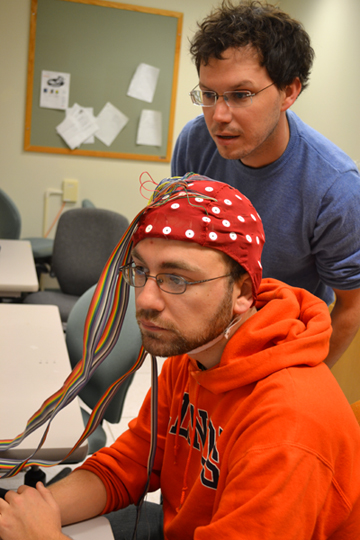
Electrical Engineering grad student Erik Johnson (lower right) and Psychology grad student Jaimie Norton (upper right) have collaborated on a number of projects. Above, they are using a brain cap to measure electric impulses of the brain.
In addition to knowing what the other disciplines do, students need to understand how they think, as well as insider jargon. "Also, what we find," Grenda explains, "especially when we're talking about the two fields, engineering and science, is that there's a huge cultural difference in those areas as far as how they approach a problem. Engineers and scientists approach a problem very differently. So making those students aware of just what those differences are is very important. Also understanding what the terminology is. There are a lot of road blocks to interdisciplinary research that we're trying to sort of smooth out to make it more effective."
Jones is familar with the road blocks, having learned how to cross the "disciplinary divide" himself. Back in 1997, he first collaborated with neurophysiologist Al Fang, an expert in how brains process sound. The project: an intelligent hearing aid that works the way the brain does. During this project, he learned to adapt to the differences in cultures.
"This whole culture thing is something that I really never gave much credence to until I actually started. There are differences there...To effectively collaborate, you’re got to be able to understand their language in order to read their papers, and understand their jargon to be able to talk to them effectively. But it’s more than that. Any effective collaborative project has to be a win-win. I’ve seen so many potentially interesting collaborations die because for one person, if they could actually address this problem, it would be a huge advance in their science, but the engineering that they needed was just standard stuff. So for the engineer, it’s not research."
To overcome this barrier, they have worked to bring the students to the point that they can do the routine things that aren't interesting for, say, the engineers. According to Jones, they've worked to help students "understand what it means to work effectively with someone in that other culture and how to make a win-win project where they’re getting value out of it as well. These are the two things that are necessary to make an interdisciplinary collaboration project actually pay off for everybody and therefore make it possible for everybody to be interested in participating."
A lot of the wisdom he and other colleagues gained regarding interdisciplinary research is wrapped up in the pièce de résistance of the IGERT—the cross-disciplinary research project which puts all the members of a cohort in a class together and forces them to make up teams that consist of at least one person from one of the other fields. Says Jones: "All of us, the faculty here who are participating, we've figured this out on our own and developed this process in collaboration you learn in doing."
According to Grenda, the students appreciate this aspect of the program immensely: "All of our students have said that that experience, working in an interdisciplinary project really was very, very valuable, very eye-opening, helped them understand what are some of the pitfalls, what are some of the difficulties, and some of the benefits to interdisciplinary research. Most problems out there require an interdisciplinary approach."
In addition to coursework, the IGERT fosters community via regular meetings, a seminar series, student talks about their research in both formal and informal settings, and an annual symposium where students are exposed to neuroengineering people from around the country. Adds Grenda, "So the coursework is significant, but it's really part of this bigger picture."
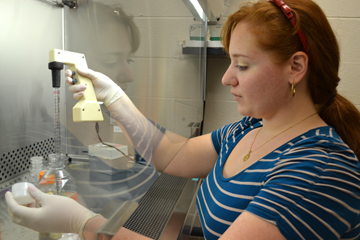
Neuroengineering IGERT graduate student Olivia Cangellaris is a bioengineering student who is working with biologist Martha Gillette.
While the IGERT program is the NSF's primary funding source for graduate students, according to Grenda, it has a secondary goal: to foster interdisciplinarity. "What the IGERT program is supposed to do is cause the university system as a whole to consider how we approach interdisciplinarity. Because it may sound easy to do, and it may be easy to make assumptions that, 'Well, why don't you guys just work on this together?' but there are a lot of barriers in place that make it difficult for faculty to share resources, or to teach in another department, or to allow students from another department to take part in these courses. So it's really a catalyst to cause these systems to consider, 'How can we break down the disciplinary silos and allow things to flow more naturally across departments?'"
Grenda sees the emphasis on interdisciplinary collaboration to be one of the key benefits to students: "I think our program really helps give a lot of value added to students because it forces them to experience interdisciplinary work and the difficulties that may come from those efforts. So we're trying to give them the awareness that's going to allow them to do it more effectively…Because most research isn't fruitful—ten experiments, and you're not going to have ten positive results. So we're giving them the tools to keep plodding forward and not become frustrated and be able use their time effectively and use other people's resources."
Jones agrees. "So at the end of our sequence, our goal is that our students will be able to go out and effectively collaborate in an interdisciplinary project with people from the other discipline who have never gone through the same process." He has devised a metaphor describing how their program prepares students to overcome the differences between disciplines: "If there's this river between, they can go all the way across the bridge instead of the other folks having to meet them half way or can only interact with people who come across. So that's the goal, and I think we've been fairly successful at that."
For more on this topic: in Neuroengineering IGERT Students Experience Interdisciplinary Research, current Neuroengineering IGERT students share about the program, interdisciplinary collaboration, and the emerging field of neuroengineering.
Story and photographs by Elizabeth Innes, Communications Specialist, I-STEM Education Initiative
More: Biology, Engineering, Funded, Graduate Education Reform, IGERT, Underserved Minorities













.jpg)
















